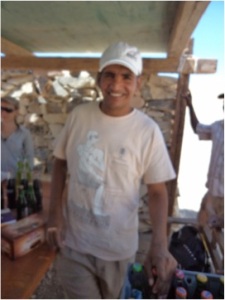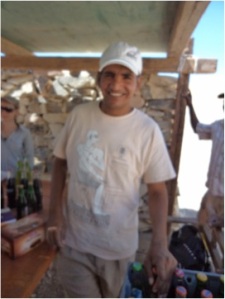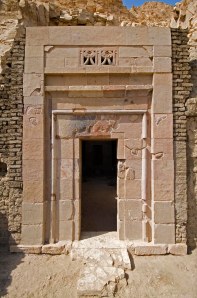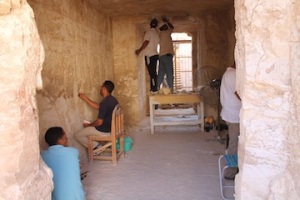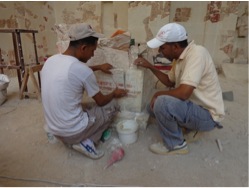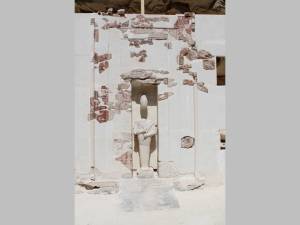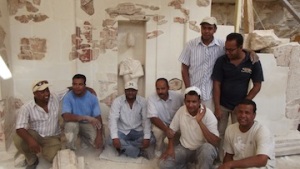For this blog entry John Billman interviews one of the most indispensable members of the South Asasif team, AbdelRazk Mohamed Ali.
John: Could you start by describing your role(s) with the South Asasif Conservation Project (SACP)
AbdelRazk: My principal role with the project is the management of the conservation work and team, , but I also act as an administration manager for the project, handling items such as sourcing conservation supplies, accommodation for volunteers and airport transportation.
John: Didn’t you also work with Elena prior to the SACP?
AbdelRazk:Yes, I worked with Elena from 2004 during the Metropolitan Museum clearance of Nespakashuty D at Deir el-Bahri and the reconstruction of its entrance gate.
John: What was your first year with the SACP?
AbdelRazk: I’ve been with the project since the very beginning in 2006 when we started together in Karakhamun (TT 223).
John: How has the project changed since then?
AbdelRazk: When we started we were essentially excavating a pile of rubbish hoping we were in the right place as we looked for the tomb, we had a small team with just 5 workmen and our focus was initial excavation, and then when we found the tomb we undertook emergency stabilization. Another challenge back then was access as part of the necropolis was still inhabited so we had to negotiate to perform even emergency conservation to the tomb of Irtieru (TT 390). Today the project is firmly established with a large team, our own supply of limestone for reconstruction and the support of sponsors and volunteers all of which enable both excavation and significant reconstruction in parallel.
John: Indeed, now the project undertakes many different tasks of reconstruction and conservation, taking for example the recently completed work in the vestibule of TT223 (Karakhamun) – what were the challenges faced here and how were they overcome?
AbdelRazk: In the vestibule there were a combination of challenges, we had some fallen pieces to reposition, numerous cracks in the wall and dust deep within the walls, but most of all past flooding had left a deposit of salt on very delicate wall surfaces. We were able to tackle these issues building on a wide range of experience including our work in the burial chamber of Karakhamun. We first undertook emergency consolidation measures as soon as possible before establishing a programme for the long-term protection of the room. This involved both mechanical and chemical cleaning to reveal hidden decoration, as well as the filling of the cracks in the wall and preventative consolidation of remaining drawings to ensure the future preservation of the room.
John: Most famous perhaps, and often featured in this blog, is the reconstruction work in the pillared halls of TT223, how initially was the approach to this work determined?
AbdelRazk: We looked at best practice elsewhere, particularly from temple sites where such large-scale reconstruction was more common. In the monumental task of reconstructing the decorative and textual program of the First and Second Pillared Halls we work in close cooperation with a team of epigraphers and art historians including Erhart Gaefe, Miguel Molinero Polo, Kenneth Griffin, Elena Pischikova and Katherine Blakeney. We were keen to be as true to the original construction materials as possible, using Egyptian limestone and our own lime-based mortar softened from the previous season.
John: What advantages does this approach give?
AbdelRazk: By focusing on materials that are natural to the Egyptian landscape, and close to those used by the original constructors of the tomb we can be more confident how these will weather over time, and how the ancient stone will interact with the modern reconstruction. Additionally as we are continually making new joins and excavation continues to find missing pieces of the tomb, a key advantage to our approach is that we can easily cut pockets to insert newly re-discovered original pieces.
John: What are the most important things in completing this work successfully?
AbdelRazk: Time and money are both key, we need long seasons to make substantial progress and funding, both for materials and tools as well as people, but most importantly a strong and skilled team.
John: You mentioned your team, everyone on site admires not only the work they do but the strong sense of commitment and team spirit that is always so evident, how do you choose a team like this?
AbdelRazk: Many of the team members have worked with me on other missions for many years, but also we need a range of skills from joins to reconstruction, and so while specific individual experience is important personal qualities such as commitment and enthusiasm are still more valuable.
John: What is it you like most about the SACP?
AbdelRazk: I very much enjoy the work, things such as the joining of fragments to reconstruct the tomb, but most of all it is our team. We have an all-Egyptian team of conservators, and we look at what we have done and it is an Egyptian team that has achieved this. The team is doing it for themselves, we all feel a real sense of achievement from the work of the project.
John: Looking back over your 8 years with the project what has been the greatest achievement so far?
AbdelRazk: It’s hard to choose one thing, but the False Door reconstruction has been really successful. It was extremely difficult and complex with a lot of calculations, but we did it and now in the Second Pillared Hall you can really start to see the tomb closer to that which it was.
John: Finally, looking forward, what do you hope to achieve with the SACP?
AbdelRazk: There is a lot of work still to do, we need more money, time, tools and people to achieve everything but I hope the journey from the Open Court to the Second Pillared Hall will be one that is closer to the ancient experience. It will be truly amazing if we can open this monument to the public, and everyone can see what we have done, I dream one day of bringing my son and daughter here to see our work.

